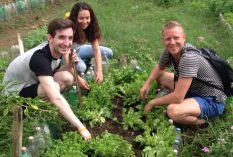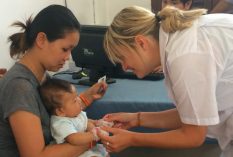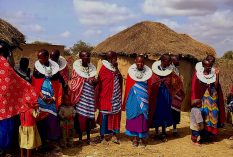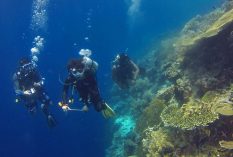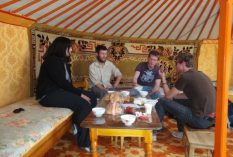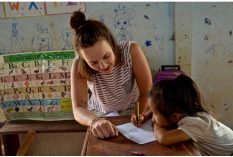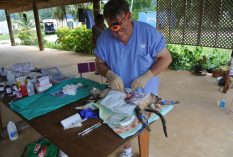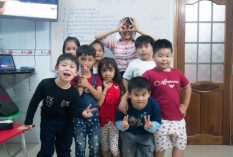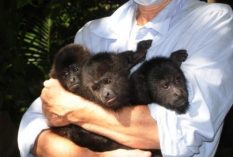June 16th 2016
Today, the islands around Koh Rong and Koh Rong Sanloem became the first Marine Fisheries Management Area (MFMA) in Cambodia. This is a big step in large-scale marine protection for the 405 km2 archipelago. The Fisheries Administration (FiA) have been working for 5 years prior to the MFMA to collect a baseline data on the biodiversity of the area. We are the 1st group of volunteers to collect data post-MFMA so hopefully there will be a resurgence in biodiversity and abundance of life. The marine habitats supports a whole host of different marine life all at different stages of development, where sea-grass beds and mangrove forests house breeding sites and nurseries and coral reefs allow for the organisms to grow and thrive. The MFMA will help drive sustainable fishing activities of the community, protect biodiversity and promote ecotourism.
July the 4th:
When I arrived at Song Saa Foundation, we got an introduction on the Tropical Marine Conservation Project (TMCP). We learned about the kind of work that they do in and around the Koh Rong archipelago and how they have helped improve the lives of the community around the island and the marine ecology on which they rely. We watched a presentation on how to identify and avoid the hazardous creatures that can be found here and how to treat the wounds they inflict. We had a community induction where we got introduced to the village and the villagers and learned about the history of the village. There was a presentation on dive standards where we learned how to use a dive planner so we can plan our own dives.
July the 5th:
The school in the village sometimes hires volunteers to help teach the local children english so I made a lesson plan for what I’m going to teach and how I’m going to teach them. They have already learned about greetings, numbers and colours so I’m going to rehearse that with the children. I’m then going to teach them about the different body parts. I’ll draw a picture of a body on the board then I’ll point to the each of the different body parts and say the names. Then on the count of 3 I’ll tell them to repeat after me. Once I’ve finished teaching them some body parts, then I’ll erase the english names from the board. I’ll point to the body part and tell the children to say the name in english. Once I’ve gone through all the body parts I’ll play head and shoulders, knees and toes and simon says with them just to solidify the knowledge with a bit of fun and games. To end the lesson, I’ll recap “Goodbye! Have a great day!” with them.
July the 6th:
I had to do my dive refresher course because my dive skills needed to be good enough to do transect surveys underwater. I had to show them I can clear my mask, find my regulator and communicate efficiently underwater. The most important skill I needed to know is how to control my buoyancy. In order to successfully do surveys underwater you need to get real up close and personal with what your recording to make sure what you’re recording and what you’re seeing match up while making the least amount of impact and least amount of damage to the environment as possible.
July the 7th:
We were shown a presentation on the introduction of the Coral Reef Ecology course where we learned about the formation and importance of coral reefs and the revenue, goods and services they provide. Coral reefs are very important to the marine ecosystems because they build structures for other organisms to live in or on. The polyps that help build these calcium carbonate structures live in them and feed on organisms that are suspended in the water. They provide hiding places and shelter for other organisms to live. There are organisms called zoozanthallae that grow on the corals and have a symbiotic relationship with the coral. The local fishermen can profit of the coral reef for their livelihood. The local villagers can profit from eco-tourism, whether from low-impact activities around the marine environment like water sports or from the ornate shells they can sell for a profit.
July the 8th:
We had a lecture on hard corals on July the 8th where we learned about coral biology, the latin names of the different types of corals there are and the different formations they grow into. We then had to know about the types of corals that will be found here around the Koh Rong archipelago for when we did our transect surveys. We learned about the 8 different forms of coral and 5 different forms of Acropora coral. We also needed to know about the 22 different types of coral, 5 different types of Acropora coral and 3 different types hydroids that we need to be able to identify. We did the coral identification test on July 12th and I got 91% for the land test and 100% for the in-water test. In the afternoon, we went diving and I had my first underwater look at what the corals looked like underwater as oppose to on a presentation and how to identify them.
July the 9th:
We had a revision session on hard corals and learned about the threats to the coral reefs. There are many things that threaten the coral reefs like humans, other organisms and diseases. Boat anchors, if deployed improperly can break off pieces of coral and damage the reef, especially if it’s dragged along the sea floor. When humans go scuba diving or snorkelling they can damage the reefs by crashing into or touching the reefs from bad buoyancy control. The oils secreted by the human hand can smother the polyps and kill the corals. Fish like the Scaridaes (parrotfish) can damage the corals by using their sharp beak like teeth to scrape off big chunks of coral, breaking it apart. There are also many diseases that can threaten the corals like black band and white band disease. In the afternoon I had 2 dives with a coral point out during each dive and coral reef ecology training.
July the 10th:
Today I got to teach the local village children some english. It was my first time so I got to sit in on one of the other volunteers give the lesson. He started of with recapping greetings and introductions with the children. Then he brought out 6 pieces of paper with 6 different colours on each piece of papaer and told the children to say the names of the colours when he held one up. Then for the new lesson he taught the children the names of 5 different animals: chicken, water buffalo, dog, cat and lizard. He would hold up a piece of paper with the picture of an animal on it then say the english name. On the count of 3 he would then tell the children to repeat after him. I would write the english name of the animals on the board then tell our translator to write the Khmer translation next to it. We then asked the children if they wanted to come out to the front of the class to act out an animal. We ended the class by recapping “Goodbye! Have a nice day!”. They had a lot of the fun and are very eager to learn.
July the 11th:
We watched a presentation on Fish Biology and Families. We learnt about the biology, diversity, adaptations of fish from their body shape, colouration, feeding and protection strategies, physiology and the different target fish families we have to learn. We then were given the latin names of the 30 different families and 29 different target species of fish we had to memorised and identify underwater. Then in the afternoon I went on a dive and had a fish and coral point out.
July the 13th:
We listened to the lecture and watched the presentation on substrates that are found underwater. We had a revision on hard corals and all of their properties then we learned about some new substrates. We learned that some substrates contribute as habitats for some other organisms (e.g. anemones for anenome fish) some filter water (e.g. sponges) and others help other other organisms to grow (e.g. sand for zooanthid growth and build their structures) while there are also substrates that can cause significant damage to the ecosystem (e.g. turf algae grows on coral smothering polyps) if it goes unchecked. In the afternoon I went on a dive and participated in survey deployment by holding the transect while the researchers recorded the organisms. I was stung by a hydroid so I had to abort the dive early.
July the 14th:
We went out in the morning to try and go diving, but there was thunder and lightning en-route to the dive site so we had to wait until the afternoon. I did 2 dives where I had another coral and fish point out. I also had more coral reef ecology training.
July the 15th:
We did 2 more dives in the morning with some more fish point outs in preparation for my fish identification test on July the 18th. In the afternoon I did some coral reef ecology training.
July the 16th:
I did a beach clean up with 10 local children who turned up to help out. Then the community manager, Het, did a workshop with us and the children on the harm plastics do to the environment and why they need to cleared up from the beach with the children while we went along the beach to pick up plastics and other trash. Then after we cleared up most of the trash we played a game of duck, duck, goose and a game of football with the children.
July the 18th:
I was given a scientific article on “Zoning Cambodia’s first Marine Fisheries Management Area” with the abstract removed and was told to write one for the article. Then I went on 2 dives where I had another fish and substrate point out. That evening I had the fish test where I got 81%.
July the 19th:
I had 1 dive where I had a substrate point out underwater in preparation for my substrate identification exam. Then we came back to the classroom to do some more revision on fish and substrates for the ID tests.
July the 20th:
I developed an eye infection during the dive from the previous day so I wasn’t allowed to dive from now until I leave. I had a revision session for fish and a presentation on substrates and I continued to work on my abstract for the scientific article. I wrote another lesson plan where I thought up new topics to teach the children like clothes, transport and food.
July the 21st:
We did a charity event called the “Boat of Hope” where the local doctor goes to different villages and helps the villagers do check ups and distribute medications. We went to the village of Sok San on Koh Rong Island. We had to walk 45 minutes from the boat to the village but we got a ride on the back of a truck back to the boat. There were 50 people waiting for us at the village centre which was nothing more than a roof with 4 sticks holding it up. The doctor then proceeded to give the villagers blood pressure tests and medications like Ibuprofen and Paracetamol and essential vitamins for the children. Some of the children had cuts and scrapes from playing so the doctor used an anti-septic betedine to help clean the wounds and patched them up and he instructed the parents on how to do the same for their children. The villagers were also given one lucky iron fish per family due to their iron deficiencies. In the afternoon when we got back, we did a second fish ID test where I got 81% again.
July the 22nd:
I did another fish review in preparation for the 3rd fish test. We were then shown a presentation and given a lecture on the invertebrates that we will need to know when doing to surveys. We learned the latin names for the invertebrates that we will need to be able to identify. I did another lesson plan for when I volunteer to teach english to the children again. I then continued to work on the abstract for the article.
July the 23rd-24th
I was unwell so I rested and 25th-26th I went to the mainland to see the doctor. While I was away the rest of the volunteers learned about transect deployment and the MFMA. When I came back from the mainland I had an invertebrate ID test where I got 84%.
July the 27th:
I had another fish and inverts ID revision session where I revised the latin identification names with the volunteer manager then on my own. I also taught an english lesson to the local school children. I started the lesson by revising greetings, colours, numbers and animals with the students then I taught them how to say car, train, motorbike and boat in english for the new lesson. Then I pointed to a mode of transportation and asked if there were any volunteers to come out and act out the vehicles. I ended the class by revising “Goodbye! Have a nice day!” in english with them.
July the 28th:
I still couldn’t go out diving due to my eye infection so I got to teach another english class to the local children. I revised greetings, colours, numbers and transportation then taught them how to say t-shirt, shorts, pants, socks, underwear and shoes in english. I put the clothes all around the classroom then told them to raise their hands if they wanted to participate in the game. I picked a volunteer to come out and choose a mode of transportation. When I said an item of clothing they had to act out their choice of vehicle to go to that item of clothing. After we finished playing the game, I ended the class by revising “Goodbye! Have a nice day!” with them. I had another fish ID test where I got 98% and an invertebrate test where I got 96%. Then I helped out one of the other volunteers prepare all the materials needed for them to do a fixed transect deployment for when they went out on his dive today.


